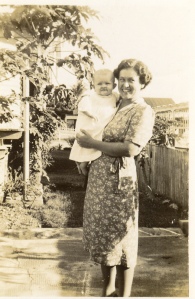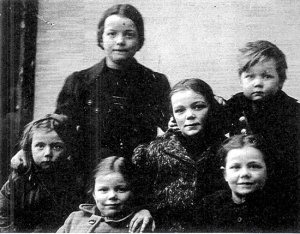If you wish click here to go to post 1 of 4
This is not my last post to this blog, but it is my 4th post dedicated to my course subject this semester which gave me this opportunity to put into place something I have procrastinated about all these years of new technology. So my English family, wherever you are, please allow me just a few lines to explain why it has become so important to me to find you.
When I was a very tiny girl, my father would come home sometimes before we were in bed. They were the good times. I’ll tell you a bit about the bad times but it would take many words to put all that down here on a blog.
We would be enticed by his ability to intrigue and jump into bed with him, all three of us, so that he would take us to the blanket show and tell stories. Of course the blanket show was a precursor to the time for bed for little people. My sister still remembers being let down by the promise of something special.
They were special. They were the times when he cherished his three children, even drunk he could still spin a yarn. He would then go ahead to tell us tales of his childhood in England. He lived in a village called Shouldham, but I did not know this for many, many years but he did talk about Kingslyn, Norfolk and Boadicea, queen of the Iceni, who led a famous revolt against Roman rule in Britain in AD 60. I really believed I was named Lynette after the ‘lyn’ in Kingslyn, in honour of this great warrior. Who can say now but it does give me a sense that there was a fondness for that area of the world, the place of his childhood. He talked about being a Barnardo’s Boy and I never got a feeling of shame about being so, it was actually pride, that he had lived through it all and become a family man. In some way it became him. He did not know very much about his past, though I now know he knew more than he let on and I guess that was his way of drowning his feeling of abandonment. He drowned that feeling also by becoming an alcoholic. The 2nd World War did not help his depression. Today we would call it PTSD.
His life in the Barnardo’s Scheme was eventful, hard, emotional and his wish to be reunited with his sisters in Canada was strong, but like many others in this system he never saw his birth family again. There were good times and he met a family called Kesby, who ‘kinda’ adopted him informally. He lived with the Kesby family and worked for their uncle, Vic Jefferies in a place called Kempsey in New South Wales. Cliff Kesby became our Uncle Cliff and our families united on holidays at various times throughout our young lives. By now Dad had married my mum Norma, and I had a brother Peter and a sister Judith. Dad worked his way through various jobs and by the time I was ten years old he was a taxi driver, later to become an owner.
Why I became so obsessed about finding my family is a question I have asked myself over these years. I think it comes from his stories of the church where he sang in the choir, of the ghost stories I thought he made up and the fact that I did not understand why he bashed my mother almost every night, along with myself. I never knew my parent’s wedding date until I was older but I always knew I was a month too early and that was why they married. As I grew, I blamed myself for making them marry and questioned why I was born. We look back now and know that this bias and bigotry and downright sexism marginalized women all over western worlds, but the world didn’t want change and the war dragged it into the modern world kicking and screaming. Some men of that time didn’t want change at all and did some horrible things to their wives. Changing society has been a difficult process with such fast and vast progress in the way we live, in spite of the technology that abounds.
 My mum was like me, and was never short about saying what she thought. She loved us with a love I can only understand in the most complete way now as an older woman. She signed the paper for me to join the Womens Royal Australian Air Force. I found freedom from being beaten and learned about life and friendship. Also finding happiness with the most devoted husband any woman could be blessed with and three beautiful children. She confided in me as a friend as well as a daughter; she was so lonely, despite having many friends. She told me very early on in my childhood, a babe really, that she tried to abort me. As stubborn now as I was then, I did not obey. I’ve probably been trying to prove my worth to the world ever since. That being said however, I needed to understand why Dad was so abusive and so damaged. I kept asking him about his family; I never stopped; never. He tired of it and would put me off by saying his sisters were Pansy and Daisy but there were hints in among the stories (he got the cuts for lying at school by the way: way too many times, and was never promoted in the Army because of insubordination), that he knew some things. The names of Chuck and Bud came into his drunken conversations and we were somehow aware the sisters were still in Canada. There was also a photo of a young nephew Jimmy, whom he thought died in the war. I think it was his link to his family.
My mum was like me, and was never short about saying what she thought. She loved us with a love I can only understand in the most complete way now as an older woman. She signed the paper for me to join the Womens Royal Australian Air Force. I found freedom from being beaten and learned about life and friendship. Also finding happiness with the most devoted husband any woman could be blessed with and three beautiful children. She confided in me as a friend as well as a daughter; she was so lonely, despite having many friends. She told me very early on in my childhood, a babe really, that she tried to abort me. As stubborn now as I was then, I did not obey. I’ve probably been trying to prove my worth to the world ever since. That being said however, I needed to understand why Dad was so abusive and so damaged. I kept asking him about his family; I never stopped; never. He tired of it and would put me off by saying his sisters were Pansy and Daisy but there were hints in among the stories (he got the cuts for lying at school by the way: way too many times, and was never promoted in the Army because of insubordination), that he knew some things. The names of Chuck and Bud came into his drunken conversations and we were somehow aware the sisters were still in Canada. There was also a photo of a young nephew Jimmy, whom he thought died in the war. I think it was his link to his family.
I never gave up hope of finding my family and about 1991 I met a mother at the school mother’s club and we talked about genealogy. She helped me find my dad’s real birthday and real name (he changed it in the Army). After Dad died in 1997, Barnado’s finally gave me his file (I was next of kin). We, rather she, found the Canadian sisters in 1999. We were well on the way to finding the English piece of the jigsaw when Judy passed away from ovarian cancer. I miss her still and always will, not because she helped me find my relatives; I miss her because we laughed and told each other the truth and had the most intense love of all things English.So for ten years as my journey in life has taken side tracks such as my devotion to the promotion and recording of the exWRAAF movement. With growing children and the mountains of joy and the valleys of despair that sometimes goes with life, Dad’s story slipped back into wishful thinking. I also felt completely inadequate about my education and lack of knowledge of grammar. That fact is still a ‘bummer’ but after enrolling in my current Diploma course, I have learned a bit more about the English language.
 So here I am, asking anyone who reads these four posts and after assessment I will continue to keep writing and adding photos and upgrading the site; anyone who by chance knows of Christopher Parr son of Jack and Patricia Parr or Lynda who would have changed her name upon marriage or even Patricia who would be of similar age to myself, please contact me. My dream of completing the puzzle, the challenge, the obsession but most of all the reason I stubbornly clung to life so many years ago.
So here I am, asking anyone who reads these four posts and after assessment I will continue to keep writing and adding photos and upgrading the site; anyone who by chance knows of Christopher Parr son of Jack and Patricia Parr or Lynda who would have changed her name upon marriage or even Patricia who would be of similar age to myself, please contact me. My dream of completing the puzzle, the challenge, the obsession but most of all the reason I stubbornly clung to life so many years ago.
It must have been to reunite the Barnardo’s Boy’s Family.
Looking forward to meeting you.
Lyn (Lynette) Mitchell (Kyte aka Kite)
Return to Home Page or Post Number 1
Photos of THEN and NOW





